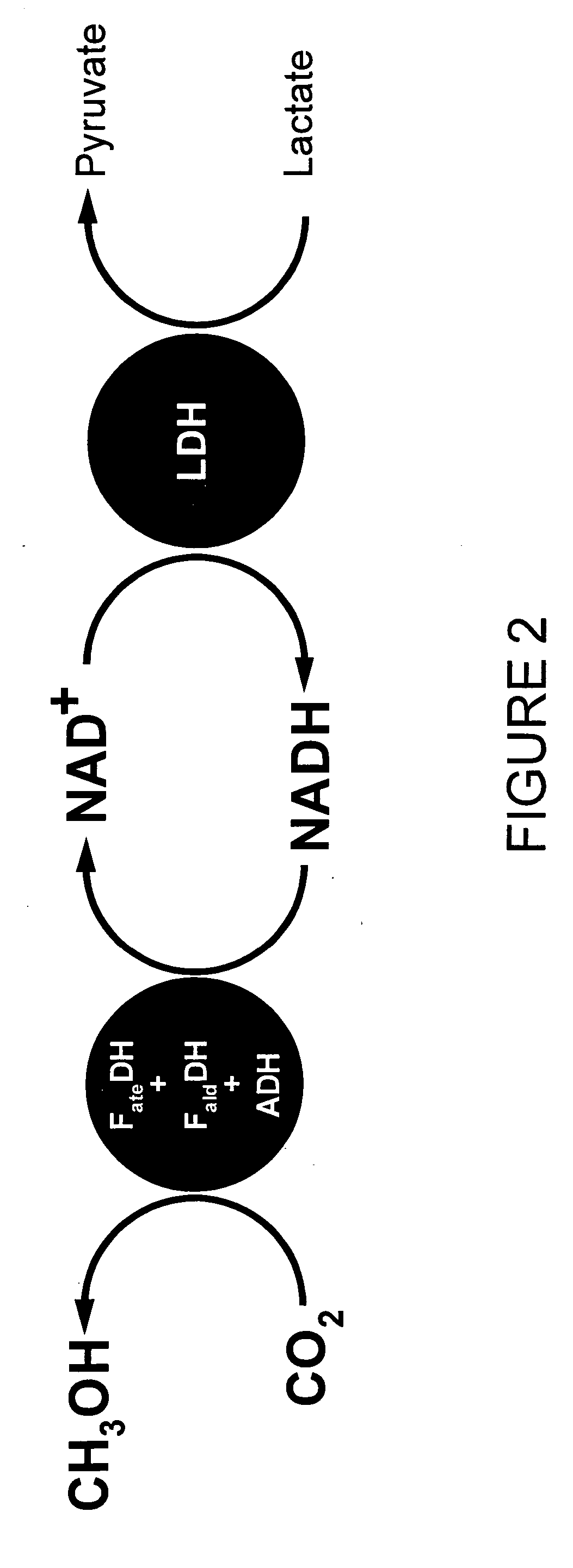Conversion of carbon dioxide to methanol in silica sol-gel matrix
a technology of carbon dioxide and methanol, which is applied in the direction of fermentation, etc., can solve the problems of inefficiency, high energy consumption, and high cost of conventional methods for synthesizing methanol from carbon dioxide, and achieve the effect of avoiding drawbacks and high conversion rates
- Summary
- Abstract
- Description
- Claims
- Application Information
AI Technical Summary
Benefits of technology
Problems solved by technology
Method used
Image
Examples
example 1
[0038] Two enzyme stock solutions, one containing the enzymes FDH, FaldDH, and ADH, and the other containing the enzymes FDH, FaldDH, ADH, and LDH, were prepared. Each stock solution was prepared by dissolving the noted enzymes in a pH 7 phosphate buffer solution such that the concentration of each enzyme was about 10 mg / mL. TMOS sol was prepared by sonicating a mixture of the precursor TMOS (1.5 mL), water (0.4 mL) and 0.04 M HCl (0.022 mL) for about twenty minutes. Two samples of TMOS sol-gel were prepared, one by mixing a portion of the TMOS sol in a 1:1 volumetric ratio with the first stock solution, the other by mixing a portion of the TMOS sol in a 1:1 volumetric ratio with the second stock solution.
[0039] Samples of each of the enzyme stock solutions were mixed with an aqueous solution of NADH (75 mg / mL) in a 1:1 volumetric ratio to produce a total volume in each case of about one milliliter. The mixtures were then exposed to various concentrations (from 0.0066 to 0.264 mole...
example 2
[0042] To study the feasibility of creating a self-sustaining system to regenerate NADH, the rate of NADH consumption in the first step of the conversion (carbon dioxide to formate ion) by means of FDH was determined. Two solutions containing FDH and NADH (one containing 0.01 M NADH and the other containing 0.025 M NADH) was bubbled with gaseous carbon dioxide. The decrease in NADH was measured using a fluorometer and a UV-visible spectrometer. When the initial NADH concentration was 0.01 M, the emission intensity of NADH at 457 nm decreased over time, from an initial level of about 850 a.u. (arbitrary units) to about 780 after five minutes, to about 550 after about fifteen minutes, to about 400 after about twenty-five minutes, to about 270 after about thirty-five minutes. However, for an initial NADH concentration of 0.025 M, an initial decrease in the emission intensity at 457 nm of NADH from 46 to 37 after five minutes was followed by an increase to about 39.5 after ten minutes, ...
example 3
[0043] Gaseous carbon dioxide was bubbled into a solution containing FDH, LDH and lactate similarly to the procedures of Example 2, above. NADH generation was measured with a UV-visible spectrophotometer for a fixed lactate concentration of 0.01 M. In this case, the absorbance at 330 nm showed a progressively increasing absorbance over time from an initial reading of about 0.32 to about 0.48 after sixty minutes.
PUM
 Login to View More
Login to View More Abstract
Description
Claims
Application Information
 Login to View More
Login to View More - R&D
- Intellectual Property
- Life Sciences
- Materials
- Tech Scout
- Unparalleled Data Quality
- Higher Quality Content
- 60% Fewer Hallucinations
Browse by: Latest US Patents, China's latest patents, Technical Efficacy Thesaurus, Application Domain, Technology Topic, Popular Technical Reports.
© 2025 PatSnap. All rights reserved.Legal|Privacy policy|Modern Slavery Act Transparency Statement|Sitemap|About US| Contact US: help@patsnap.com


